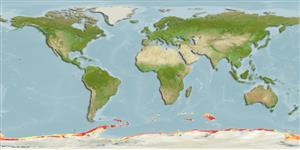Environment: milieu / climate zone / depth range / distribution range
Ecologia
marinhas demersal; oceanódromo (Ref. 51243); intervalo de profundidade 1 - 1010 m (Ref. 114491). Polar; 45°S - 78°S, 180°W - 180°E
Circumpolar south of Antarctic Polar Front, but not found in Ross Sea; adults only in higher latitudes (South Orkneys, South Shetlands, Peter Island) and south of the Weddell-Scotia confluence, but adults and juveniles in the region of South Sandwich I, South Georgia and Bouvet. Reported from off the Cape, South Africa and from 43°17'S, 48°55'E (Ref. 4066).
Comprimento de primeira maturação / Tamanho / Peso / Idade
Maturity: Lm 7.4 range ? - ? cm
Max length : 11.5 cm SL macho/indeterminado; (Ref. 114491); 10.3 cm SL (female); peso máx. publicado: 15.00 g (Ref. 124149); idade máx. registrada: 4 anos (Ref. 94119)
Espinhos dorsais (total): 0; Raios dorsais (total): 14-16; Espinhos anais 0; Raios anais : 19 - 22
Oceanic and mesopelagic, found in the upper 100 m south of the Antarctic Polar Front but deeper northwards (Ref. 4066). Adults take more euphausiids and also prey upon polychaetes. The diet of juveniles of less than 6 cm SL consists mainly of copepods, with some euphausiids and hyperiids. Possibly the most common myctophid occurring south of the Antarctic Polar Front.
Ciclo de vida ou comportamento de acasalamento
Maturidade | Reprodução | Desova | Ovos | Fecundidade | Larvas
Hulley, P.A., 1990. Myctophidae. p. 146-178. In O. Gon and P.C. Heemstra (eds.) Fishes of the Southern Ocean. J.L.B. Smith Institute of Ichthyology, Grahamstown, South Africa. (Ref. 5182)
Status na Lista Vermelha da UICN (Ref. 130435)
Ameaça para os humanos
Harmless
Uso pelos humanos
Pescarias:
Mais informação
ColaboradoresFotosStamps, Coins Misc.SonsCiguateraVelocidadeTipo de nataçãoÁrea branquialOtólitosCérebrosVisão
Ferramentas
Relatórios especiais
Baixar XML
Fontes da internet
Estimates based on models
Preferred temperature (Ref.
123201): -0.2 - 1.2, mean 0.4 °C (based on 610 cells).
Índice de diversidade filogenética (Ref.
82804): PD
50 = 0.5312 [Uniqueness, from 0.5 = low to 2.0 = high].
Bayesian length-weight: a=0.00832 (0.00469 - 0.01475), b=3.09 (2.94 - 3.24), in cm total length, based on LWR estimates for this species & (Sub)family-body (Ref.
93245).
Nível Trófico (Ref.
69278): 3.2 ±0.4 se; based on diet studies.
Generation time: 6.5 ( na - na) years. Estimated as median ln(3)/K based on 2
growth studies.
Resiliência (Ref.
120179): médio(a), tempo mínimo de duplicação da população 1,4 - 4,4 anos (K=0.17-0.25; tmax=11).
Fishing Vulnerability (Ref.
59153): Moderate vulnerability (41 of 100).
Nutrients (Ref.
124155): Calcium = 63.5 [23.8, 202.8] mg/100g; Iron = 0.649 [0.225, 1.681] mg/100g; Protein = 15.4 [13.5, 17.5] %; Omega3 = 0.92 [0.39, 2.31] g/100g; Selenium = 13.9 [4.6, 38.8] μg/100g; VitaminA = 49.6 [8.9, 301.0] μg/100g; Zinc = 0.657 [0.347, 1.130] mg/100g (wet weight); based on
nutrient studies.
